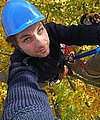26.01.2023 | Lea Huber | News WSL
Non-native forest tree species can reduce native species diversity if they are planted in uniform stands. In contrast, the effects of introduced species on soil properties are small. This was found by an international review study with the participation of the Swiss Federal Institute for Forest, Snow and Landscape Research WSL.
Curse or blessing? Opinions are divided on non-native* tree species. In addition to native species, many foresters also plant non-native species that can withstand the increasing summer drought. In various parts of Europe, the latter are already important suppliers of timber. However, conservationists fear ecological damage, for example if native species are displaced or tree pathogens and insect pests are introduced.
Now a team of European researchers, led by Thomas Wohlgemuth of WSL, has looked at the state of knowledge on the ecological consequences of alien tree species in Europe. They analysed the results of 103 studies on seven such species. All of these studies had investigated how stands dominated by non-native tree species affected biodiversity or soil condition under the trees compared to stands of native tree species. The organisms studied included plants, mosses, microorganisms and insects from the forest floor to the treetops.
Of the seven alien species studied, only the Douglas fir is currently planted in larger numbers in the Swiss forests. While foresters used to value its fast, straight growth and its versatile wood, today they appreciate its higher drought tolerance compared to spruce. Other species are problematic because they can spread uncontrollably. The North American Robinia, for example, is invasive and can displace native species. It was already introduced in Europe 400 years ago and used in Switzerland, among other things, to stabilise soils.
Negative effects on biodiversity predominate ¶
Across the 103 studies, the consequences of non-native species for biodiversity were negative. Comparisons from 20 studies show, for example, that on average fewer insect species live on and in Douglas fir than in spruce or beech stands. Robinia also reduces the diversity of insects, eucalyptus that of birds. This is hardly surprising, says Wohlgemuth, head of the WSL Forest Dynamics Research Unit. Because: "These results apply to comparisons between pure stands." In continuous, uniform plantations, many alien species clearly have worse impacts than native species.
But alien species do not only have negative impacts. Most of them do not affect soil properties. The easily degradable needles of Douglas firs can even make more nutrients available than the poorly degradable spruce needles. "When it comes only to soil properties, the Douglas fir has no negative impact," Wohlgemuth says. In general, an equal number of studies found positive and negative effects of the seven non-native species on the soil.
Furthermore, it makes a difference whether the alien species are more closely or more distantly related to European tree species. "Tree species without closer relatives, such as eucalyptus and acacia from Australia, reduce species diversity more strongly across all studies than closely related species, such as Douglas fir and wild black cherry from North America," adds Martin Gossner, head of the WSL Forest Entomology Group and second author of the study.
It all depends on the management ¶
Management has a significant influence on whether Douglas fir or other tree species are good or bad for a forest overall. Uniform and dense Douglas fir stands are unsuitable habitats for many organisms. However, the same is true for spruces, which have been planted extensively for timber production in lowland areas of Central Europe over the last 100 years. On the other hand, Douglas firs in stands of native forest trees, individually or in small groups, would hardly disturb the ecosystem, Wohlgemuth says: "We conclude that the impact on native biodiversity is low with mixed-in Douglas firs."
Should foresters plant non-native tree species or not? Despite certain negative aspects, Wohlgemuth does not recommend total renunciation. "Particularly in the case of Douglas fir, the facts show that moderate admixture in stands has little impact on native biodiversity, while at the same time preserving ecosystem services such as the production of construction timber. This is especially true when other, less drought-resistant conifers are increasingly lacking with regard to unchecked climate change."
*Alien organisms or non-native organims are organisms that do not naturally occur in Switzerland or in other EFTA and EU member states (according to the Ordinance on the Handling of Organisms in the Environment; SR 814.911, Art. 3.f)
Always up to date: Subscribe to the WSL Newsletter
Contact ¶
Publications ¶
Wohlgemuth T., Gossner M.M., Campagnaro T., Marchante H., van Loo M., Vacchiano G., … Silva J.S. (2022) Impact of non-native tree species in Europe on soil properties and biodiversity: a review. NeoBiota. 78, 45-69. https://doi.org/10.3897/neobiota.78.87022 Institutional Repository DORA
Copyright ¶
WSL and SLF provide the artwork for imaging of press articles relating to this media release for free. Transferring and saving the images in image databases and saving of images by third parties is not allowed.






